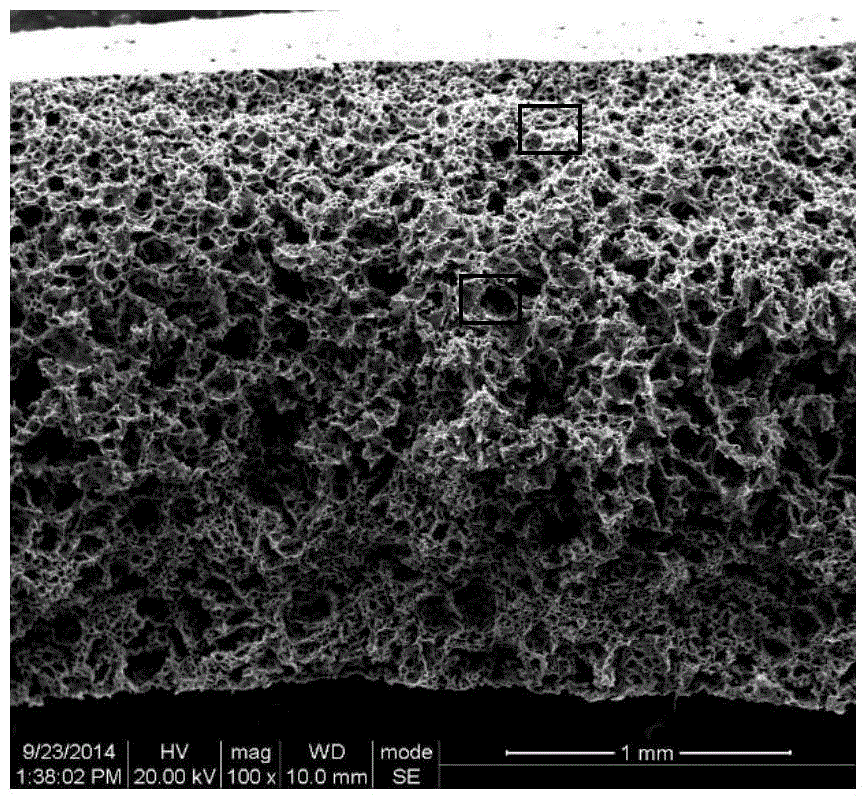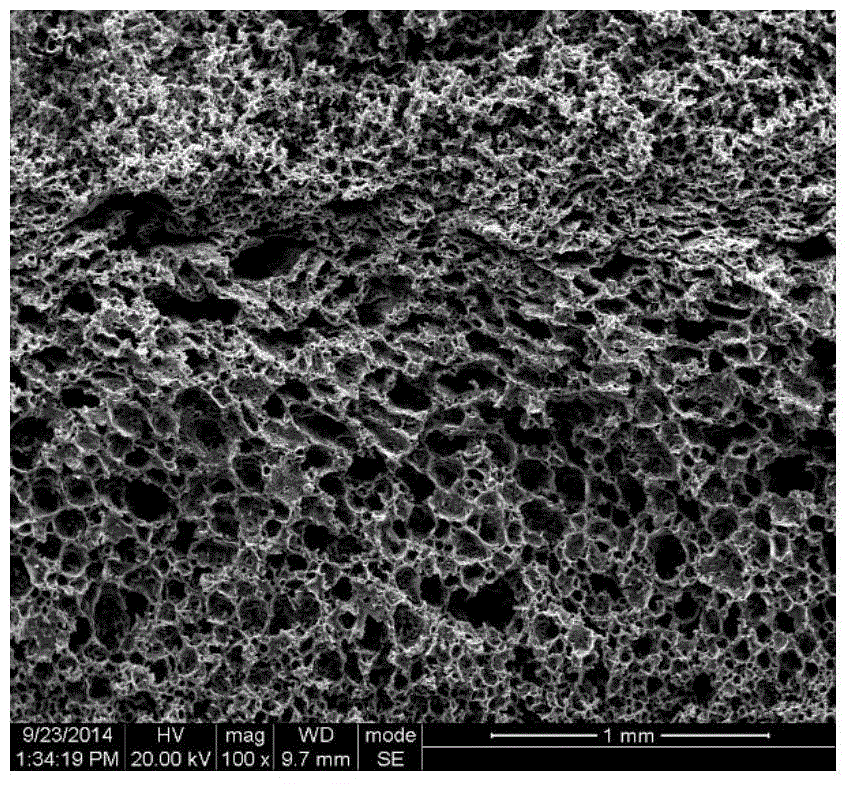A kind of porous polyurethane film with gradient pore structure for artificial skin and its preparation method
A polyurethane film, gradient hole technology, applied in medical science, prosthesis and other directions, can solve the problems of difficulty in resisting the invasion of external bacteria, the upper layer of silicone rubber has too large pore size, and cannot be used for a long time, so as to keep the wound moist, excellent mechanical properties, The effect of good water permeability
- Summary
- Abstract
- Description
- Claims
- Application Information
AI Technical Summary
Problems solved by technology
Method used
Image
Examples
Embodiment 1
[0052] Dissolve four parts of 25g of medical-grade polyurethane in 200mL of N,N-dimethylformamide at 60°C, then add 60g, 80g, 100g, and 120g of sodium citrate with a particle size of 75-150μm, and stir mechanically After 1 hour, defoam for 20 minutes at room temperature under a vacuum of 0.06 MPa. The defoamed suspension was evenly poured into a polytetrafluoroethylene mold with a film thickness of 2mm, and then placed in absolute ethanol at 25°C for phase separation and solidified to form a film. The cured polyurethane porous membrane was soaked in deionized water at 25°C for 72 hours to fully filter out the porogen, and the water was changed every 24 hours. The polyurethane porous membrane from which the porogen was removed was dried in a blast oven at 40° C. to obtain a porous polyurethane membrane with a gradient pore structure.
Embodiment 2
[0054] Dissolve 25g of medical-grade polyurethane in 200mL of N,N-dimethylformamide at 60°C, then add 80g of sodium citrate with a particle size of 75-150μm, stir mechanically for 1 hour, and then dissolve it at room temperature under a vacuum of 0.06 Degassing at MPa for 20min. The defoamed suspension was evenly poured into the polytetrafluoroethylene mold for three times, and the film thickness was 1mm each time. After the film was coated, it was put into 25°C absolute ethanol for phase separation, and solidified to form a film. The polyurethane porous membrane cured for the third time was soaked in deionized water at 25°C for 72 hours to fully filter out the porogen, and the water was changed every 24 hours. The polyurethane porous membrane from which the porogen was removed was dried in a blast oven at 40° C. to obtain a porous polyurethane membrane with a gradient pore structure.
Embodiment 3
[0056] Dissolve 10g of medical-grade polyurethane in 200mL of N,N-dimethylformamide at 20°C, then add 10g of sodium citrate with a particle size of 20-75μm, stir mechanically for 1h, and then dissolve it at room temperature under a vacuum of 0.06 Degassing at MPa for 10 minutes. Pour the defoamed suspension evenly into a glass mold with a coating film thickness of 1mm, then put it in absolute ethanol at 20°C for phase separation, and solidify to form a film. The cured polyurethane porous membrane was soaked in deionized water at 5°C for 72 hours to fully filter out the porogen, and the water was changed every 24 hours. The polyurethane porous membrane from which the porogen was removed was dried in a blast oven at 40° C. to obtain a porous polyurethane membrane with a gradient pore structure.
PUM
| Property | Measurement | Unit |
|---|---|---|
| concentration | aaaaa | aaaaa |
| particle diameter | aaaaa | aaaaa |
| concentration | aaaaa | aaaaa |
Abstract
Description
Claims
Application Information
 Login to View More
Login to View More - R&D
- Intellectual Property
- Life Sciences
- Materials
- Tech Scout
- Unparalleled Data Quality
- Higher Quality Content
- 60% Fewer Hallucinations
Browse by: Latest US Patents, China's latest patents, Technical Efficacy Thesaurus, Application Domain, Technology Topic, Popular Technical Reports.
© 2025 PatSnap. All rights reserved.Legal|Privacy policy|Modern Slavery Act Transparency Statement|Sitemap|About US| Contact US: help@patsnap.com



